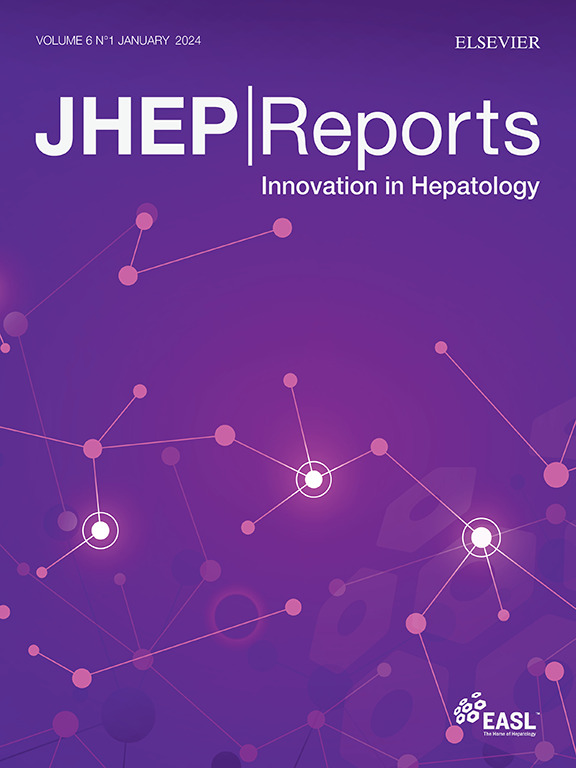AFP的肿瘤负荷提高tace治疗的HCC患者的生存预测:一项国际观察性研究☆。
IF 9.5
1区 医学
Q1 GASTROENTEROLOGY & HEPATOLOGY
引用次数: 0
摘要
背景与目的:目前肝细胞癌(HCC)经动脉化疗栓塞(TACE)患者的预后模型尚未得到广泛验证和广泛接受。我们的目标是开发和验证一个结合肿瘤负荷和生物学的连续模型,用于个体生存预测和风险分层。方法:总体而言,来自5个国家39个中心的4377名TACE推荐的初始治疗候选人入组,并分为培训、内部验证和两个外部验证数据集。新模型采用Cox多变量回归分析,并与我们的原始6和12模型(最大肿瘤大小[ts,厘米]+肿瘤数量[tn])和其他可用模型在预测准确性方面进行了比较。结果:所建模型命名为“6- 12模型2.0”,生成的模型为“ts + tn + 1.5×log10 α -胎蛋白(AFP)”,具有良好的判别性(c指数0.674)和校准性(Hosmer-Lemeshow检验p = 0.147),优于现有模型。根据不同的AFP水平(≤100、100-400、400-2,000、2,000-10,000、10,000-40,000和bbb40000 ng/ml)以及相应的肿瘤负荷截止值(8/14、7/13、6/12、5/11、4/10和任何肿瘤负荷)提出了易于使用的分层;即AFP水平为400- 2000 ng/ml时,分层应为低(≤6)/中(6-12)/高危(> -12)层。因此,它可以将患者分为三个不同的风险类别,中位总生存期为45.0 (95% CI, 40.1-49.9)、30.0 (95% CI, 26.1-33.9)和15.4 (95% CI, 13.4-17.4)个月(p)。结论:6- 12模型2.0显著提高了个体结局预测,更好地分层推荐TACE候选人;因此,该模型可用于临床实践和试验设计。影响和意义:在这项国际多中心研究中,我们开发并内部和外部验证了一种新的HCC候选人预后预测模型,该模型将是理想的TACE患者。该模型被称为6- 12模型2.0,是基于来自五个国家39个中心的4377名患者。该模型提供个性化的结果预测,在所有数据集和子集中优于原始的6和12模型得分和其他现有指标。根据不同的甲胎蛋白(AFP)水平和相应的肿瘤负荷临界值,可将患者划分为生存预后差异显著的3个风险层,为今后试验设计控制研究异质性和确定目标人群提供参考框架。本文章由计算机程序翻译,如有差异,请以英文原文为准。

Tumor burden with AFP improves survival prediction for TACE-treated patients with HCC: An international observational study☆
Background & Aims
Current prognostic models for patients with hepatocellular carcinoma (HCC) undergoing transarterial chemoembolization (TACE) are not extensively validated and widely accepted. We aimed to develop and validate a continuous model incorporating tumor burden and biology for individual survival prediction and risk stratification.
Methods
Overall, 4,377 treatment-naive candidates for whom TACE was recommended, from 39 centers in five countries, were enrolled and divided into training, internal validation, and two external validation datasets. The novel model was developed using a Cox multivariable regression analysis and compared with our original 6-and-12 model (the largest tumor size [ts, centimetres] + tumor number [tn]) and other available models in terms of predictive accuracy.
Results
The proposed model, named the ‘6-and-12 model 2.0’, was generated as ‘ts + tn + 1.5×log10 alpha-fetoprotein (AFP)’, showed good discrimination (C-index 0.674) and calibration (Hosmer–Lemeshow test p = 0.147), and outperformed current existing models. An easy-to-use stratification was proposed according to the different AFP levels (≤100, 100–400, 400–2,000, 2,000–10,000, 10,000–40,000, and >40,000 ng/ml) along with the corresponding tumor burden cutoffs (8/14, 7/13, 6/12, 5/11, 4/10, and any tumor burden); that is, if the AFP level was 400–2,000 ng/ml, the stratification should be low-(≤6)/intermediate-(6–12)/high-risk (>12) strata. Hence, it could divide the patients into three distinct risk categories with a median overall survival of 45.0 (95% CI, 40.1–49.9), 30.0 (95% CI, 26.1–33.9), and 15.4 (95% CI, 13.4–17.4) months (p <0.001) from low-risk to high-risk strata, respectively. These findings were confirmed in validation and subgroup analyses.
Conclusions
The 6-and-12 model 2.0 significantly improved individual outcome predictions and better stratified the candidates recommended for TACE; thus, this model could be used in both clinical practice and trial design.
Impact and implications:
In this international multicentre study, we developed and internally and externally validated a novel outcome prediction model for candidates with HCC who would be ideal for TACE. The model, called the 6-and-12 model 2.0, was based on 4,377 patients from 39 centers in five countries. The model offers individualized outcome prediction, outperforming the original 6-and-12 model score and other existing metrics across all datasets and subsets. Based on different levels of alpha-fetoprotein (AFP) and corresponding cut-offs of tumor burden, patients could be stratified into three risk strata with significantly different survival prognoses, which could provide a referential framework to control study heterogeneity and define the target population in future trial designs.
求助全文
通过发布文献求助,成功后即可免费获取论文全文。
去求助
来源期刊

JHEP Reports
GASTROENTEROLOGY & HEPATOLOGY-
CiteScore
12.40
自引率
2.40%
发文量
161
审稿时长
36 days
期刊介绍:
JHEP Reports is an open access journal that is affiliated with the European Association for the Study of the Liver (EASL). It serves as a companion journal to the highly respected Journal of Hepatology.
The primary objective of JHEP Reports is to publish original papers and reviews that contribute to the advancement of knowledge in the field of liver diseases. The journal covers a wide range of topics, including basic, translational, and clinical research. It also focuses on global issues in hepatology, with particular emphasis on areas such as clinical trials, novel diagnostics, precision medicine and therapeutics, cancer research, cellular and molecular studies, artificial intelligence, microbiome research, epidemiology, and cutting-edge technologies.
In summary, JHEP Reports is dedicated to promoting scientific discoveries and innovations in liver diseases through the publication of high-quality research papers and reviews covering various aspects of hepatology.
 求助内容:
求助内容: 应助结果提醒方式:
应助结果提醒方式:


